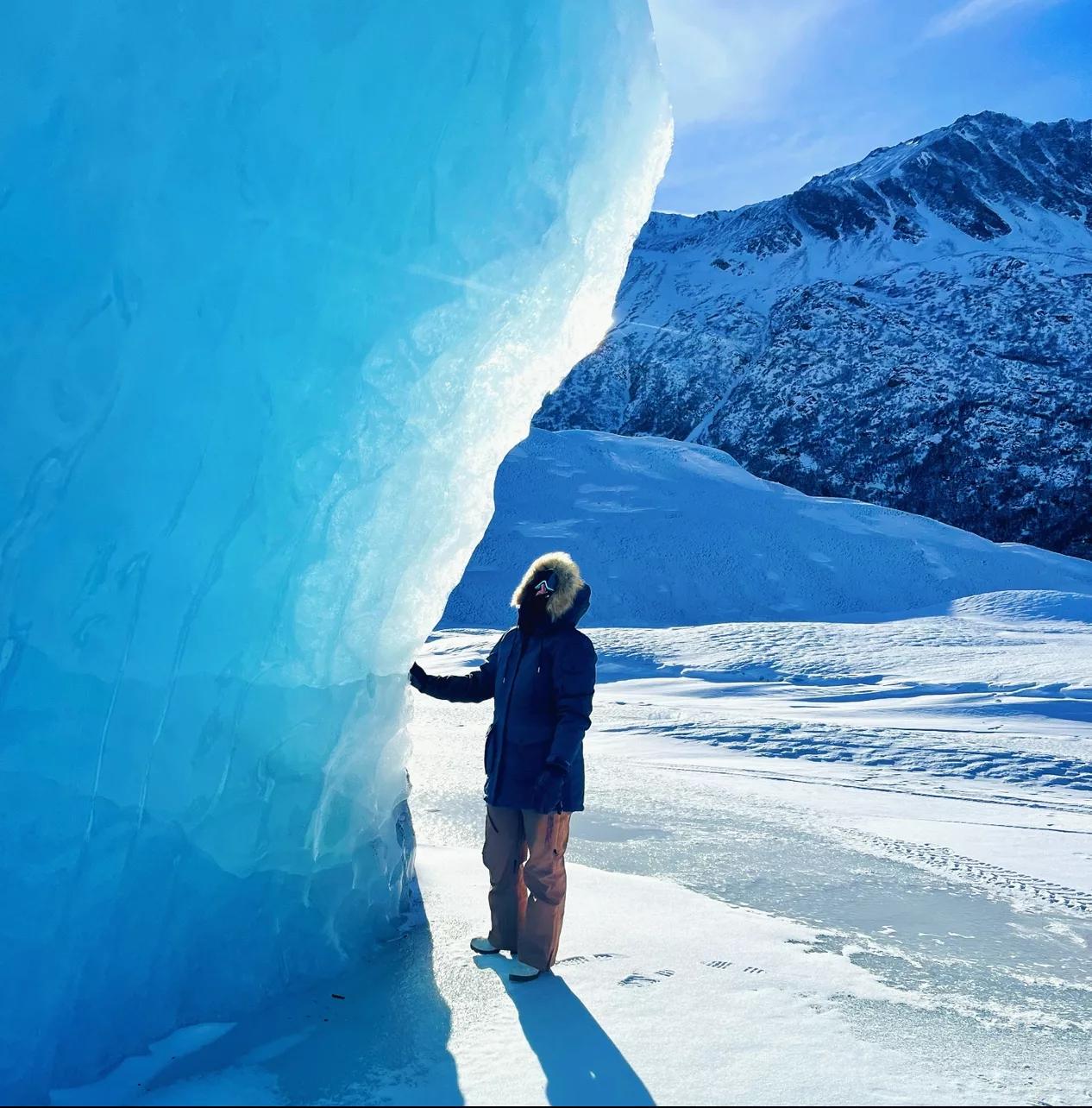Welcome to Alaska! I have the incredible privilege of calling this state home, so I often share my out-of-state travels here. But today, I am taking you on an Alaska glacier tour that just happens to be my backyard. I have plenty of photos for your enjoyment as we learn how glaciers exist, a little history of the glacier we are visiting, the effect of climate change on glaciers, and then take a ride to one of the most beautiful sights in the world.

What’s in a glacier?
Glaciers begin to form when snow remains in the same area year round, where enough snow accumulates to transform into ice. Each year, new layers of snow bury and presses down on the previous layers. This compression forces the snow to recrystallize, creating ice crystals similar to the size and shape of sugar grains.
Over time, the grains grow larger and the air pockets between the grains get smaller, causing the snow to slowly compact and increase in density. At this point, it is about two-thirds as dense as water. Over time, larger ice crystals become so compressed that any air pockets between them are very tiny. For most glaciers, this development takes more than a hundred years.

The world’s glaciers have an estimated total area of about 270,000 square miles. Most of the world’s glaciers are in Antarctica. Glaciers are mainly found near the poles, but glaciers exist on all the world’s continents, except Australia. Outside of the poles, Alaska is the next location to find the largest glacier coverage. Let’s discover how much of Alaska is covered by these incredible formations.
Alaska Glaciers & Climate Change
Around 23,000 square miles of Alaska are covered in glaciers, with roughly one quarter of Alaska’s glaciers exist within national parks. Much of the land in Alaska has been formed and carved by glaciers that continue to affect the waters, and ecosystems of this unique state This influence caused the National Park Service scientists to monitor glacier change which lead to the discover that glaciers are shrinking in area and volume across the state.
The effects of climate change are felt more in high-latitude regions like Alaska than in most other regions of the world. According to the National Park Service scientists glaciers shrank by 8% between 1050 and 2000. From 1985 to 2020, glacier-covered area in Alaska decreased by 13%, indicating that the rate of glacier loss accelerated in recent decades. As our climate continues to warm, glacial shrinking could continue to affect the Alaskan landscape just like the Knik Glacier receding carved the valley where I eventually built my home.

Knik River Glacier
The Knik Glacier is located 50 miles north of Anchorage in Alaska’s Chugach Mountains. Knik Glacier is one of the biggest glaciers in south central Alaska. At 25 miles long and over 5 miles across, Knik Glacier actually first developed during the Pleistocene ice age 600.000 years ago when the Chugach Mountains were covered in ice over 1/2 mile thick. Knik Glacier first connected to a massive ice field that extended hundreds of miles into the ocean.
Knik Glacier carved hundreds of valleys and shaped rock into landscapes of ethereal natural beauty. Surrounded by 10,000 ft snow-covered peaks, hanging glaciers, and waterfalls, the Knik Glacier has created one of Alaska’s most spectacular natural amphitheaters. Knik Glacier is the centerpiece of the 17,000 acre Lake George National Natural Landmark. The National Natural Landmark Program recognizes over 500 sites in the United States. Established in 1962, the program aims to encourage voluntary preservation of sites that illustrate the geological and ecological history of the United States and to strengthen the public’s appreciation of America’s natural heritage. In order to be selected a site must of national significance and the best example of a regions biotic or geologic features.

The Knik Glacier was selected because of a rare geologic phenomenon that occurs here called a “jokulhlaup” which means an ice dammed lake. Jokulhlaups occurred here annually until 1967. In winter the Knik Glaciers would advance and press its mass of ice, up to 400ft thick, against the side of Mt. Palmer and block the flow of water from Lake George. In spring the Lake George Valley behind Knik Glacier would begin to fill with water. The 5 mile lake would swell to over 20 miles and water levels would raise 180 ft. The water levels would eventually rise over the ice dams and the annual breakout would occur. Millions of gallons of angry surging water would roar down the valley loaded with silt, debris and glacial ice. This natural wonder occurred annually until 1966 . The history of this valley was forever changed over the years when this water would flood towns located below or block transportation between the valley and Anchorage where most supplies were gained. Luckily after 1967 a decrease in glacial advance has prevented the overflow of Lake George, but one can still fly up to see the lake today.
The early events caused by the advance of the Knik Glacier have been replaced by a receding Knik Glacier. In 1997 the Knik glacier began shrinking due to the first recognized global warming trend. Recently, a new lake over 3 miles long and over 700ft deep has appeared at the face of the glacier that increases in size every year. This lake is the frozen paradise I stood on just last week.
Adventure on Knik Glacier
Helicopter tours to Knik Glacier have become increasingly popular over the past few years as other previously popular glaciers shrank in size enough to be harder to see or explore. The Knik Valley is home to locals year-round and receives a flood of tourists who visit the lodge in the summer when there is seasonal housing for vacation rentals. I feel very lucky to load up my family on our ATV’s packed with hot cocoa, snacks, and extra warm clothes to take a 40 minute ride through our favorite local trails and across the frozen lake to our glacier. The beauty that surrounds on a bluebird day is indescribable and I am in awe of the view every single time we visit. Some days you’ll see brave fat tire bikers, (or rescue a few who don’t anticipate the challenging 14 mile ride), or ice climbers enjoying the natural landscape the glacier provides.
I hope this journey provided some new insight into the effects our glaciers are feeling due to the every changing climate as well as some interesting facts to share with your friends. Photos don’t capture the full beauty but my goal was to bring the essence of this otherworldly view to you. May you see and experience this beautiful state, and possibly come play on our glacier someday.
As Always,
Nourish your Wanderlust, Elevate your Vitality
Lee


